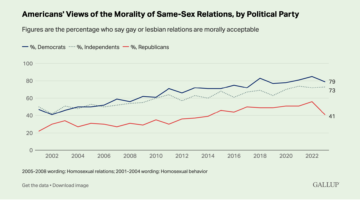10 Scientific Facts About Sexual Orientation
September 19, 2014 by Justin Lehmiller
There are a lot of myths and misconceptions out there about sexual orientation concerning everything from the origin of homosexuality to the sexual behaviors of gay, lesbian, and bisexual individuals. So let’s take a look at what the research actually says. Below, I’ve compiled a list of ten of the most interesting scientific facts about sexual orientation that everyone should know.
1.) According to the National Survey of Sexual Health and Behavior, 7.8% of men and 6.8% of women in the U.S. identify as something other than heterosexual (check out this infographic for a more detailed breakdown of these numbers).
2.) Homosexuality is related to the structure of the brain—for example, research finds that it is associated with the degree of symmetry of the left and right hemispheres, as well as the number of nerve connections in the amygdala, a brain structure that plays an important role in the processing of emotional information.
3.) Contrary to popular belief and what you might have learned from watching Southpark, “scissoring” (i.e., genital-genital touching) is not something that all lesbian and bisexual women practice, nor is the most common sexual activity in female couples—oral sex, vaginal penetration, and mutual masturbation are all practiced more frequently.
4.) Likewise, although gay and bisexual men’s sex lives are often stereotyped as involving a lot of anal sex with anonymous partners, this is not an accurate reflection of reality. In fact, research finds that most gay and bisexual men report that their most recent sexual partner was someone they knew (e.g., a boyfriend or friend), and the most common sexual activities reported were kissing, oral sex, and mutual masturbation.
5.) A small percentage of the population is asexual and has no desire for partnered sexual activity. Many scientists consider asexuality to be a distinct sexual orientation, at least partly because asexuality is correlated with a lot of the same biological factors as homosexuality. You can learn more about asexuality in this article.
6.) Male bisexuality is real and it is not “a layover on the way to gaytown,” as Carrie Bradshaw once claimed. Genital arousal studies have found that bisexual men can indeed exhibit strong arousal in response to both male and female sexual stimuli.
7.) Some research suggests that our eyes may reveal our sexual orientation. Specifically, the degree to which our pupils dilate (i.e., become larger) when exposed to different types of sexual imagery is related to our patterns of sexual attraction. Learn more about this fascinating research here.
8.) Lesbians report having orgasms with greater frequency that heterosexual women. We don’t know for sure why this is the case, but it could be because female same-sex couples report spending longer on sexual activity than male-female couples. Men’s sexual orientation is not related to their frequency of reaching orgasm.
9.) Gay parents do not have a tendency to raise gay children. In fact, children raised by gay parents are no more likely to be gay themselves relative to children raised by heterosexual parents [1]. Besides, if sexual orientation is socially transmitted from our parents, then why are so many gay and bisexual people raised by heterosexual parents?
10.) Access to marriage rights appears to be good for the health of same-sex couples. In fact, studies have found that same-sex couples who marry tend to have fewer healthcare visits and live longer lives than their unmarried counterparts.
Want to learn more about Sex and Psychology? Click here for more from the blog or here to listen to the podcast. Follow Sex and Psychology on Facebook, Twitter (@JustinLehmiller), or Reddit to receive updates. You can also follow Dr. Lehmiller on YouTube and Instagram.
[1] Fitzgerald, B. (1999). Children of lesbian and gay parents: A review of the literature. Marriage and Family Review, 29, 57-75.
Image Credit: iStockphoto
You Might Also Like:

Dr. Justin Lehmiller
Founder & Owner of Sex and PsychologyDr. Justin Lehmiller is a social psychologist and Research Fellow at The Kinsey Institute. He runs the Sex and Psychology blog and podcast and is author of the popular book Tell Me What You Want. Dr. Lehmiller is an award-winning educator, and a prolific researcher who has published more than 50 academic works.
Read full bio >


